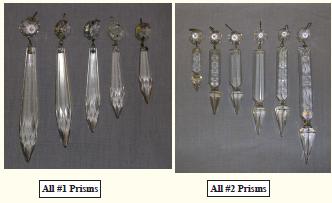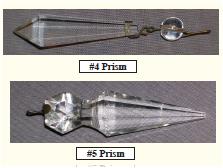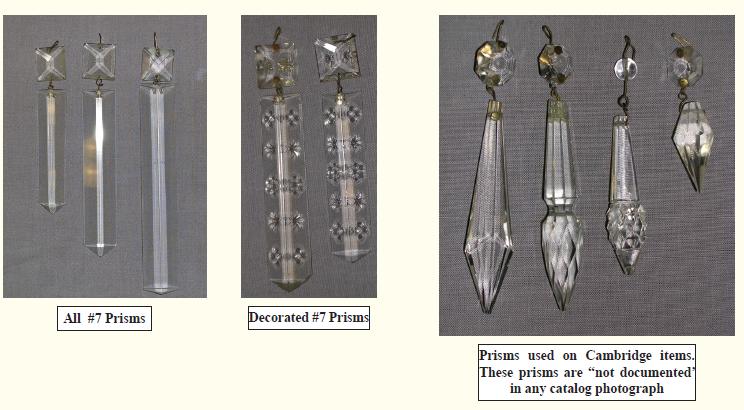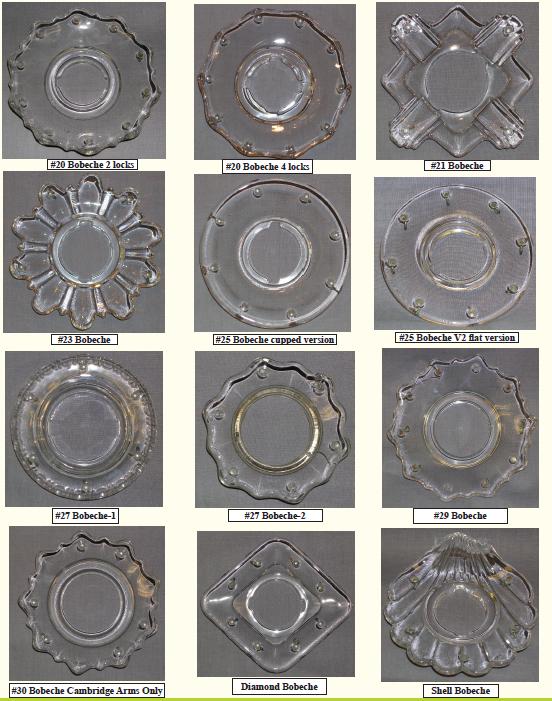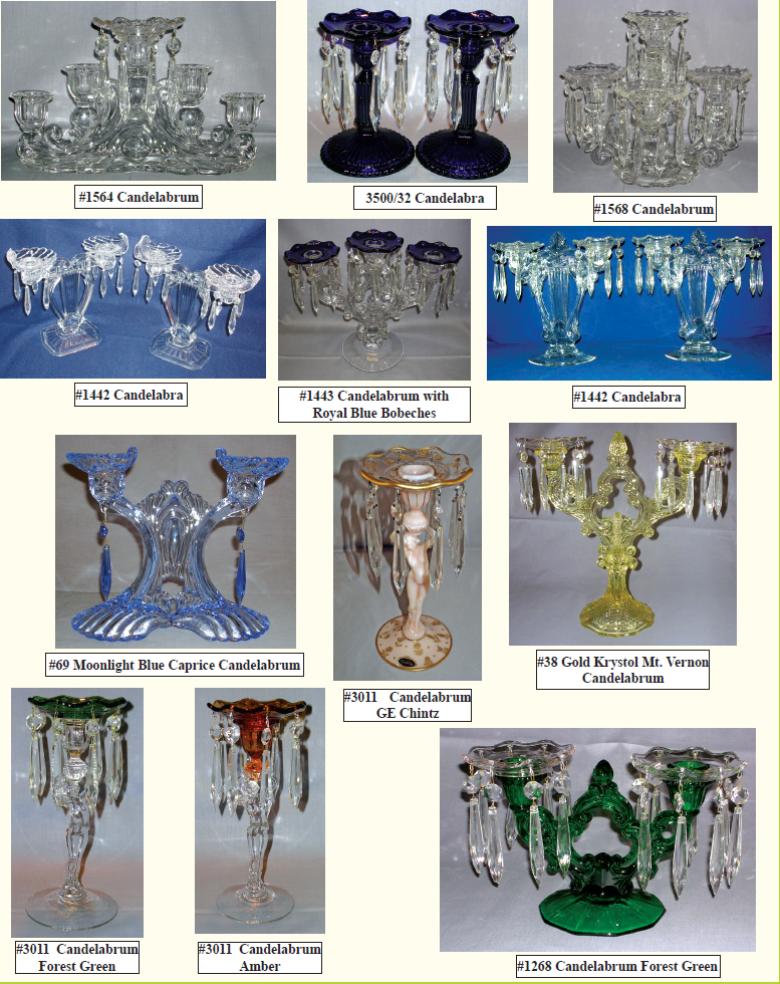Epergnes and Their Parts - Part I
by David Ray
Issue No. 445 - February 2011
At the 2003 Convention, I had an opportunity to lead an
educational program titled "Epergnes and Their Parts".
Since that time, many members have looked to me for
answering their questions about arms, prisms, bobeches, and
flower vases. The focus of this article is to provide a
visual reference for the accessories used in creating
candelabrums, epergnes, and epergnettes. This article
 focuses on the different sytles of bobeches and prisms used
on Cambridge candelabrums, while the second article will
center around the different arms and vases used to create
epergnes.
focuses on the different sytles of bobeches and prisms used
on Cambridge candelabrums, while the second article will
center around the different arms and vases used to create
epergnes.
In January 1927, Wilber Orm filed an application for a locking bobeche. From the sketch appearing on the patent, it appears the original locking bobeche possessed four locks. Throughout the duration of the Cambridge Glass Company, bobeches were made having four locks, two locks, or zero locks. Only with the #19 and #20 bobeches did the number of locks vary.
The original version of the #19 and #20 bobeche
possessed four locks and had a smooth scalloped edge. At
some point in the late 1930's, two new bobeches were
introduced and were assigned #19 and #20. These bobeches
are very similar to their original versions, but the smooth
scalloped edge was replaced with a more jagged edge. Both
variations of the #19 and #20 bobeches appear to have been
produced simultaneously, which is evident on pages 254 and
255 of the 1940 Catalog. During the 1940's, the scalloped
version of the #19 and #20 bobeches were phased out and the
pointed version continued to be produced until the 1950's.
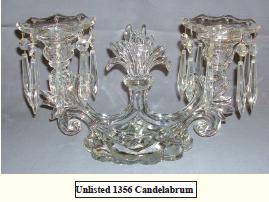 Future mould modifications were made to these bobeches and
the number of locks was reduced from four to two and then
eventually to zero. A very similar version of the #19 is
shown in the 1940's catalog and was listed as #28. This is
a mystery.
Future mould modifications were made to these bobeches and
the number of locks was reduced from four to two and then
eventually to zero. A very similar version of the #19 is
shown in the 1940's catalog and was listed as #28. This is
a mystery.
Bobeches are the key component in creating a
candelabrum. A candelabrum is any candlestick possessing at
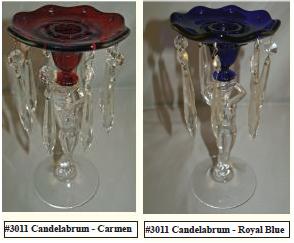 least one bobeche. The candlestick portion of a candelabrum
can be found in nearly every color produced by the
Cambridge Glass Company after 1930. The vast majority of
these colored candelabrum bases were fitted with crystal
bobeches. Although the patent for a bobeche was applied for
in 1927, there are no catalog photographs of candelabrums
until 1930. All candelabrums pictured in the 1930-1934
Catalog appear to possess four-lock bobeches.
least one bobeche. The candlestick portion of a candelabrum
can be found in nearly every color produced by the
Cambridge Glass Company after 1930. The vast majority of
these colored candelabrum bases were fitted with crystal
bobeches. Although the patent for a bobeche was applied for
in 1927, there are no catalog photographs of candelabrums
until 1930. All candelabrums pictured in the 1930-1934
Catalog appear to possess four-lock bobeches.
In addition to crystal, the early 4-lock version of the #19 bobeche was produced in amber, amethyst, carmen, forest green, and royal blue. Finding one of these colored bobeches is extremely difficult. Nude stem collectors highly desire theses bobeches to adorn their nude candlesticks, but colored bobeches could have been sold on any candlestick.
The two-lock version of the #19 bobeche as well as the
#21 and #23 bobeches were produced in Moonlight Blue. The
Moonlight #21 bobeche was part of the #76 Caprice epergne
and the #23 bobeche was part of the #71 and #79 Caprice
candelabrums. The Moonlight Blue #19 bobeche was part of
the #78, #1268, #1356, and #1358 candelabrums and the
#1358/5 and #1358/8 epergnes. Although the #1268, #1356,
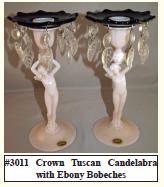 #1358, #1358/5, and #1358 were not officially part of the
Caprice line, these candelabrums and epergnes were likely
sold as accessory pieces.
#1358, #1358/5, and #1358 were not officially part of the
Caprice line, these candelabrums and epergnes were likely
sold as accessory pieces.
One pair of #19 bobeches has been found in Ebony adorning a pair of Crown Tuscan nude candlesticks. These would be considered extremely unusual.
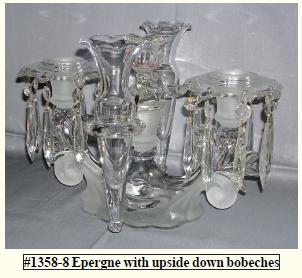 Before ending the discussion on bobeches, I must address
the "upside down" bobeches. A pre-1940 catalog supplement
pictures epergnes possessing upside down bobeches. Upside
down bobeches were produced using either the scalloped or
pointed versions of the 4-lock #19 bobeche with the metal
pins inserted the opposite direction. The upside down
bobeche only appears on epergnes and not candelabrums.
Before ending the discussion on bobeches, I must address
the "upside down" bobeches. A pre-1940 catalog supplement
pictures epergnes possessing upside down bobeches. Upside
down bobeches were produced using either the scalloped or
pointed versions of the 4-lock #19 bobeche with the metal
pins inserted the opposite direction. The upside down
bobeche only appears on epergnes and not candelabrums.
The other bobeche designs produced by the Cambridge
Glass Company are featured on the next page. Bobeches
produced by the Cambridge Glass Company were designed to
accommodate four, five, six, eight, or ten prisms. The
Cambridge Glass Company purchased the majority of their
prisms from Europe. I have been able to identify twelve
different prisms listed in Cambridge catalogs, but other
styles of prism have been found on Cambridge Glass. Only
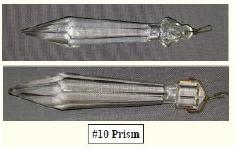 two prisms were actually produced by the Cambridge Glass
Company. The #10 prism on the left is pictured on all of
the large hurricane lamps in the 1940's catalog. The
similarly shaped star-jeweled prism is found on the large
hurricanes pictured in the 1949 and 1957-58 catalogs. It is
possible the original prism mould was modified in the
1940's and both prisms were identified as #10.
two prisms were actually produced by the Cambridge Glass
Company. The #10 prism on the left is pictured on all of
the large hurricane lamps in the 1940's catalog. The
similarly shaped star-jeweled prism is found on the large
hurricanes pictured in the 1949 and 1957-58 catalogs. It is
possible the original prism mould was modified in the
1940's and both prisms were identified as #10.
The #1 prism is extremely common and was used by several other glass companies, but the other styles can be very difficult to find. Some of the Cambridge catalogs specify the type of prism used for a particular candelabrum or epergne. In the spreadsheet, I have listed the specific lengths of each prism, but due to the hand finishing their lengths do vary.
